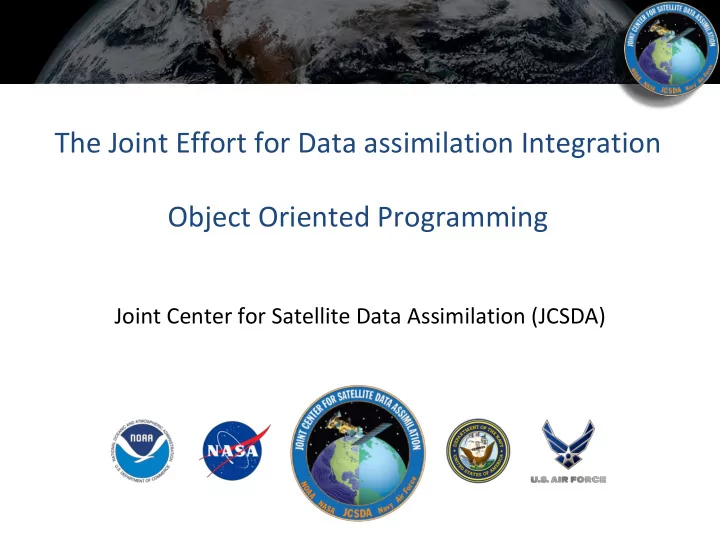

The Joint Effort for Data assimilation Integration Object Oriented Programming Joint Center for Satellite Data Assimilation (JCSDA)
Very brief introduction to object oriented programming Concepts that are the most useful to work with JEDI Learning all the subtleties of OOP can take years
An object is an instance of a class, it contains data and methods The data part of a class is most of the time private (ensure encapsulation) Methods are instructions sent to objects of a class to perform actions (often using the data) Methods can be public or private (or protected) The interface stays, the implementation can change
Subclasses can be defined from a base class - A subclass inherits the data and methods from its parent class - A subclass can add its own data and methods - A subclass can overwrite (specialize) an inherited method Base classes are very useful for - Factorizing common code between subclasses - Defining common interfaces (abstract base class) It is very common to hold objects whose subclass is not known in pointers to the base class - Use smart pointers to avoid memory leaks - Use factories to create objects based on input parameters Each object carries its methods so the appropriate one will be called
Deep inheritance structures are usually not a good idea - There are often simpler ways to solve the problem (composition) - It is not efficient (resolving of virtual tables) - They introduce too much “coupling” The deepest inheritance tree in OOPS (Minimizer) has two levels - First level sets the RHS (primal, dual, saddle point) - Second level to select the actual minimization algorithm An object of a subclass can be passed anywhere an object from a parent class is expected (there is no exception to this rule) If exceptions (if statements to determine the subclass) are needed, inheritance is not the right approach
� � class CovarianceMatrix { � public: � CovarianceMatrix(const Geometry &, const Configuration &); � ~CovarianceMatrix(); � virtual Increment multiply(const Increment &) const =0; � } � class SpectralCovariance : public CovarianceMatrix { � public: � CovarianceMatrix(const Geometry &, const Configuration &); � ~CovarianceMatrix(); � Increment multiply(const Increment &) const; � } � class WaveletCovariance : public CovarianceMatrix { � public: � CovarianceMatrix(const Geometry &, const Configuration &); � ~CovarianceMatrix(); � Increment multiply(const Increment &) const; � }
� � � � class State {} � class OceanState : public State {} � class AtmosphereState : public State {} class Model { � class Model { � void forecast(State &, const Duration) const =0; � void forecast(State &, const Duration) const =0; � } � } � class OceanModel : public Model { � void forecast(State &, const Duration) const; � } � class AtmosphereModel : public Model { � void forecast(State &, const Duration) const; � } � Inheritance is not for everything!
module generic_min It is possible to write generic interface min subroutines or functions in Fortran module procedure min_int, min_real end interface However, the code is repeated for contains each implementation function min_int(x, y) result (z) In C++ the code is not repeated: integer x, y, z if (x<y) then z = x template<class T> else T min(const T x, const T y) { z = y if (x < y) { endif return x; end function min_int } else { return y; function min_real(x, y) result (z) } real x, y, z } if (x<y) then z = y else The advantage becomes obvious z = x when the function is long and endif complex: 4D-Var cost function … end function min_real end module generic_min
Templates in C++, “duck-typing” in python, nothing in Fortran OOPS/JEDI uses generic programming more than inheritance The technique of TRAITS is used to define a coherent set of classes: struct QgTraits { typedef qg::GeometryQG Geometry; typedef qg::StateQG State; typedef qg::ModelQG Model; typedef qg::IncrementQG Increment; typedef qg::ErrorCovarianceQG Covariance; // this example is incomplete } Actual classes Names used in JEDI
One class = One responsibility The purpose of a class should fit in one (simple) sentence Interfaces should be easy to use correctly, difficult to use incorrectly They should make sense for somebody who knows the domain
GOTO IF Variables Unstructured Procedural Object Functional Code Code Oriented Programming Each new programming model removes the most common source of bugs in the previous one
Recommend
More recommend